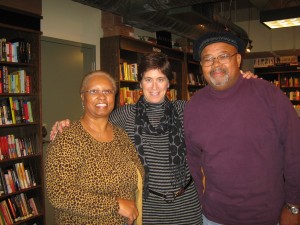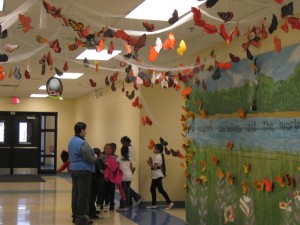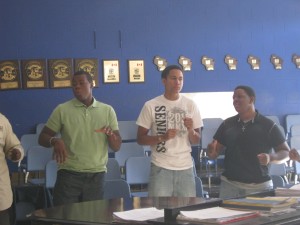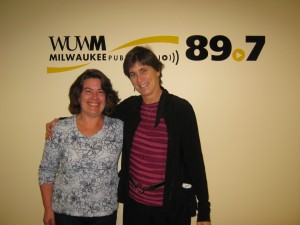What a whirlwind two-day trip to Milwaukee! I hadn’t been there since 1977, when I studied at UW Madison and forgot how friendly people are in the Midwest.
I visited Milwaukee at the invitation of Christina Ratatori, who is a dance teacher in the public schools and founder of a.r.t. (Artists Rallying Together), a new group comprised of both artists and arts teachers who want to ensure that young people are exposed to a rich arts curriculum in schools. They propose to do this by using both certified teachers and also visiting artists, who would participate in residencies, do special projects, and work with afterschool programs. Christina founded the organization for two reasons: one, because her artist friends could never figure out how to gain entrance to schools as arts instructors, and another because of her awareness of how few certified arts teachers were currently in schools. So instead of passively bemoaning budget cuts, she created a.r.t. to try to solve the problem!
Book Talk
Boswell Books is an independent bookstore on the East Side of Milwaukee and co-sponsored my talk (along with a.r.t.). An engaging cross-section of participants showed up, including a couple who had worked at Cambridge Rindge and Latin and Madison Park High Schools in the “old days.” It was great fun catching up with them. A member of the Milwaukee Symphony came, as well as arts teachers and folks interested in education, including a former school board member. We had a lively discussion about our own educational dilemmas as well as the present situation in the Milwaukee Public Schools.
While I cannot come close to even pretending to be an expert on Milwaukee schools, I found the situation in Milwaukee almost a wake-up call for what I believe is bound to happen in other cities if we don’t get it together. Milwaukee has a public school system, a charter school system, and a choice system. The choice system is essentially vouchers, and choice schools are for the most part private and parochial schools. Depending on your perspective you’d either say the choice system has drained the public school system of valuable resources or you’d say it has given parents genuine new opportunities to choose schools. The charters come in two flavors: ones run by the district, which operate much like Boston’s pilot schools (unionized) and others which are run by non-profits, universities, and the like (non-unionized). The city is an example for many of what a good market system can bring; for others it is an example of business principles gone awry.
In addition to the book talk at Boswell Books, I also visited two exceptional schools: Milwaukee High School for the Arts and La Escuela Fratney/The Fratney School, a bilingual pre-k-5th grade.
The Fratney School/La Escuela Fratney
I had been introduced to Fratney’s Principal Rita Tenorio and 5th grade teacher Bob Peterson through Vito Perrone almost 20 years ago. (Bob is also one of the founders of Rethinking Schools, my favorite education journal). I was so pleased to finally get to visit the school “in the flesh.”
From the moment I walked into the main lobby and engulfed by hundreds of butterflies balancing gracefully in a net, I knew this school stood for more than just making AYP. Creativity, self-expression, and the importance of being bilingual are the foundations of Fratney. In every room I visited, students focused on projects and group activities. Rooms are labled “Zona Español” or “Zona Inglés” and students, as in many bilingual schools, shift from weeks of instruction in English to instruction in Spanish. I was sad to learn that because of budget cuts there is only one arts teacher in the school. They also no longer have a physical education teacher, just an itinerant who is there for only six weeks. The school worked hard to keep their librarian, and the library is absolutely the center and heart of the school.
Unlike the anti-union messages in Waiting for Superman, this is a school that is strongly unionized, collaborative, hard-working, and dedicated to kids and families. I left feeling so happy for the 400 families that get to experience La Escuela Fratney. I also loved that on Fridays all faculty wear Fratney t-shirts of different vintages, and I especially loved meeting the FEMALE head custodian, Joan, who does a fabulous job keeping the school pristine.
Milwaukee High School for the Arts
At our sister art school, MHSA, Principal Barry Applewhite was very gracious with his time and we “floated” (his description) in and out of classrooms for about two hours. While I didn’t have an opportunity to see academic classrooms, I was smitten quite ill with “edifice envy.” MHSA is situated in a large former vocational school building. Every room has big windows and is BIG! There is space to move! Even with a student body of 900 students, it never felt crowded. There are three lunch periods, and the cafeteria was very calm. Students have 30 minutes for lunch and at the 15 min bell they can go outside to the small yard and parking lot to just breathe fresh air, play games or chat.
Throughout my visit I was struck by the ease and order of the place. Students know where they belong; safety personnel (three uniformed safety people as well as someone sitting in the front just signing people in) know all the kids and really help the administration keep things moving. Teachers are in the hallways and in the cafeteria as well, helping to keep everyone on track. I saw no hall wanderers. The day is scheduled into 10 periods with each class 52 minutes long. Students have two periods of art a day (not necessarily back-to-back) and some seniors have more arts when they have finished academics requirements.
Students audition in eighth grade. There are approximately 325 musicians (vocal and instrumental), approximately 125 in theatre and the rest in dance, creative writing and visual arts. There are also about 80-100 students (out of that 900) who are “COs” or central office transfers. Many of these students are special needs and according to Principal Applewhite, although they many not have a major, fit right into the arts classes. It is the school’s intent to get them into a major. Some don’t get to take the advanced arts classes but they have the opportunity to do so if they excel. (I witnessed students just fitting in a number of classes).
I had the chance to visit the head of music—choral teacher Raymond Roberts, who has been there for a long time (since the beginning?). He is a product of Dallas’ Booker T. Washington arts high school and is determined even with many constraints, to build a program based on what he learned there. Students take one year of theory, one year of piano, and their third and fourth years are in two ensembles (as opposed to just one for the first two years). I watched his women’s beginning choir class working on Rollo Dilworth’s Jordan’s Angels. I also got to hear his upper-house jazz ensemble perform Horace Silva’s Song for My Father. I loved their ability to improvise! I loved the energy of this group, their skills, humility, and pride all mixed together. I also enjoyed watching the way Raymond remained calm as he worked with his beginning students. I promised Barry I wouldn’t steal Raymond, but I’d sure like to do an exchange with our students and his (Barry tells me he sends their students to England each year, but Boston is a lot closer)!
We also visited a theatre class taught by Gus Rich. There are two and a half faculty in the theatre department (the half is also a physics teacher), and they teach everything. Gus is the technical director for the school and teaches acting, costume, lighting, stage craft, and theory. It seemed like every arts teacher there taught a LOT of classes and wore many hats (similar to BAA). Gus also produces two dozen shows for the school each year. The class of sophomores was working on Comedy of Errors and appeared to be doing well independently. I was then invited to watch a five minute scene from the play. While the class meets in the theatre (which is a large “old school” auditorium better suited for dance and music), most theatre performances are held in the 110-seat black box. (“Better suited for young voices,” Gus told me). Twice a year, there are portfolio presentations, which count for 1/5 of the semester grade. In these presentations, students must show through acting and researched writing, how they have grown as an artist.
Both Barry and Gus were surprised at my question about kids that don’t make the grade. What happens to them? Through informal mentoring with older students, or mentoring from teachers, students do meet their benchmarks. There is a safety exam at the end of sophomore year that students take until they get the necessary grade. “It’s as much for them as for me,” Gus said. “I have to know they can use the equipment.”
And what about attrition? Very few kids are counseled out. “Once we accept them, our job is to keep them,” Principal Applewhite said.
Barry Applewhite used to hold two jobs—Head of Music for the district, as well as principal of MHSA. I loved watching him go into a room where a small jazz ensemble was playing. “You aren’t playing that right,” Barry said to the drummer. “That’s not a Latin beat. I played that when I was in college!” The musicians and all students, obviously respect, admire, and love Barry. He’s an artist like them, and knows what it is to play well. The orchestra has 60 string players, because Milwaukee supports an elementary and two middle schools for the arts.
Barry also took me “floating”—his word—as in “let’s float” through visual arts classes, where beginning students were working on portraits and other non-VA students were working on a variety of projects and drawings.
I also met their Parent Coordinator who runs the Parent Center, located off the cafeteria. It was filled with spirit wear, a much-used microwave, newsletters, and sign-up sheets for various clubs, field trips and other activities. There is even a sports program that MHSA students can participate in. The Parent Coordinator is also a member of the school’s foundation called Catch a Rising Star.
All of the teachers (academic and arts) work within the framework of Understanding By Design, and submit unit guides to meet the criteria of that approach. Barry has high hopes that this overarching framework will give the faculty more common ground to discuss lessons, assessment, and issues of teaching and learning. Currently there are 82 sophomore students who have not made AYP in Math, so they have recently started an afterschool math program to address this.
Besides the general feeling of calm and focus mixed with wonderful energy, I was taken with the way the “COs” were integrated into the school. I wondered whether the faculty and staff were pleased with the artistic quality of the students (I had the sense that they were, but didn’t really probe and ask). I couldn’t quite figure out the schedule (even though I took a picture of it!), but it seems to operate as a 10-period day, where students have the flexibility to choose from a multitude of classes. When I asked Barry about challenges, he quickly repeated the familiar refrain: money and the necessity of more support from the district. I also heard this from others outside of the school, who have great respect for the school’s accomplishments but worry about its sustainability without clear district support. An arts school simply costs more. We all know that!
On the Radio
My radio interview with Bonnie North on NPR radio affiliate, 89.7 WUWM went really well. I will post a link to the sound file very soon!
Milwaukee Art Museum
In addition to my school visits, I also had the opportunity to visit the new Milwaukee Art Museum designed by architects Eero Saarinen, David Kahler, and Santiago Calatrava (and yes, at noon the wings actually do move!).
Ethan Lesser, Chipstone Foundation curator, was giving a class on American Decorative Arts to about 40 University of Wisconsin students, and I was able to tag along for a bit. It was fun to hear him and the students speak about the difference between studying fine art objects and three-dimensional objects like a teapot or a chair. There was also a 20th century European Design exhibition and I saw that wild new vacuum cleaner designed by James Dyson of England. I had just read about it in The New Yorker and it sure is cool!
So, I really packed lots into just two days. Overall, I must say I enjoyed being in the Midwest with people who are genuinely nice. It is certainly a very different vibe than Boston!














THANK YOU. Just what I needed to read today – I’m looking for a K4 and was researching Escuela Fratney. The other school visits were also insightful, I appreciate it.